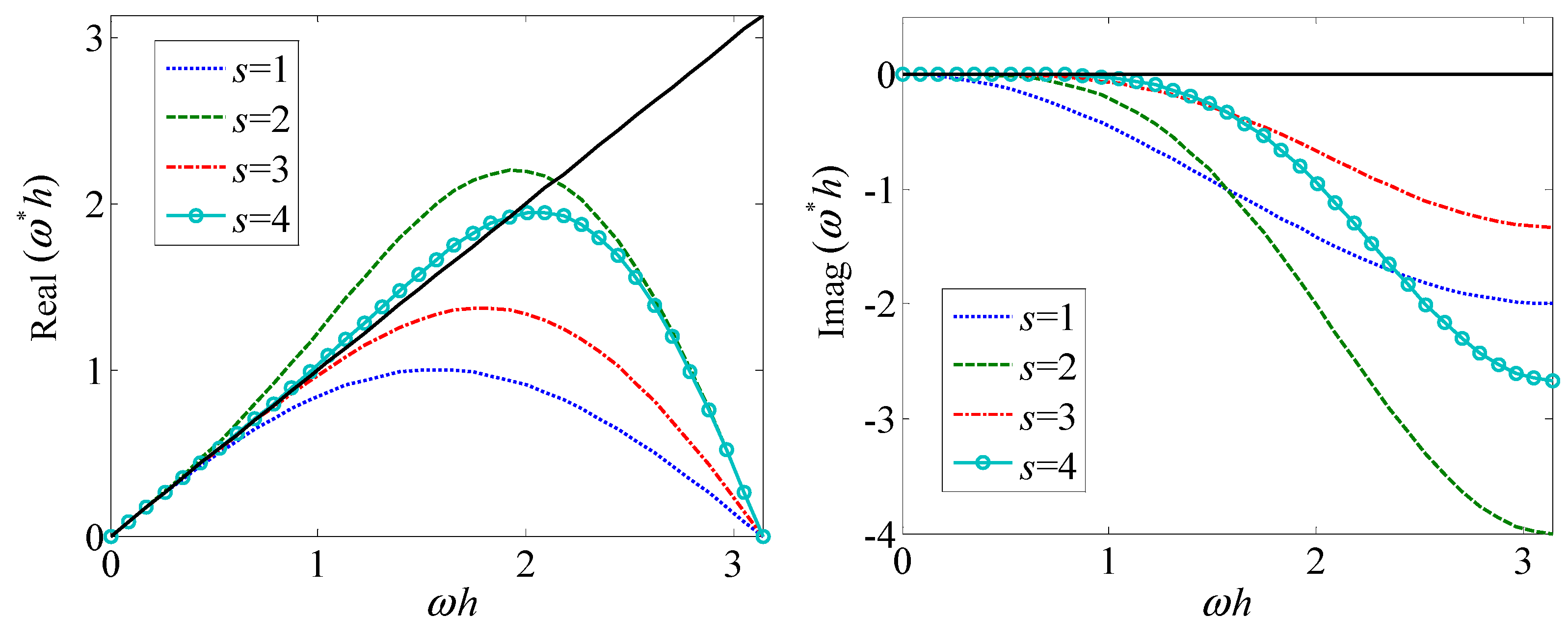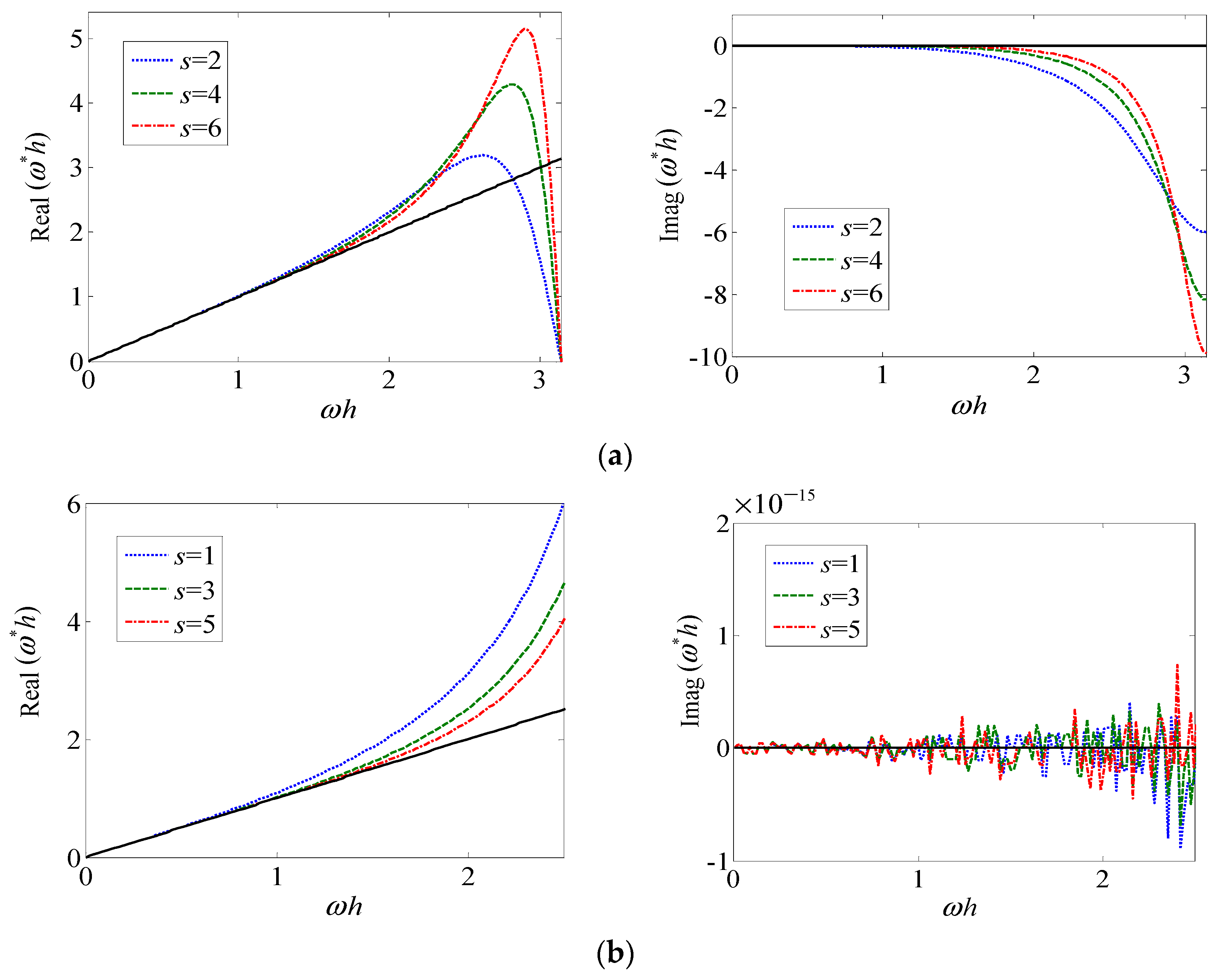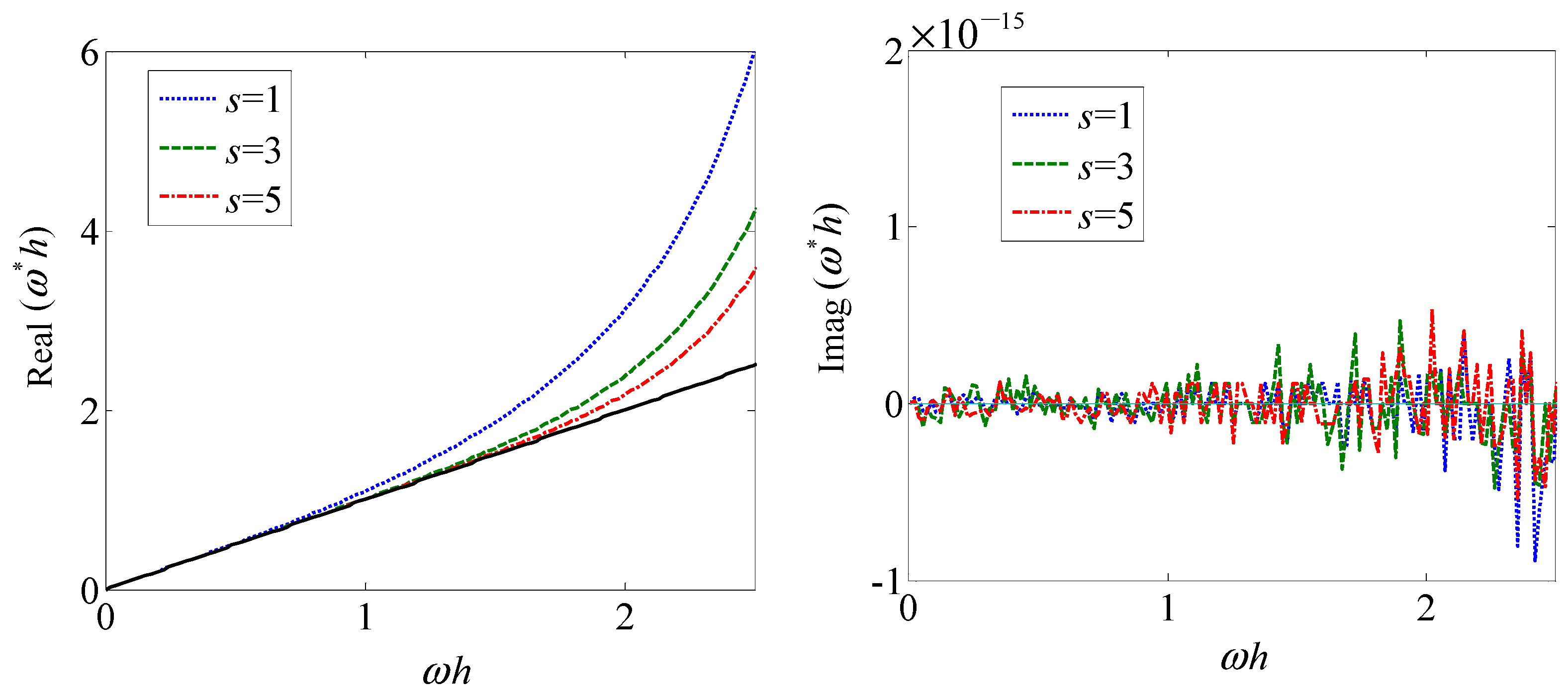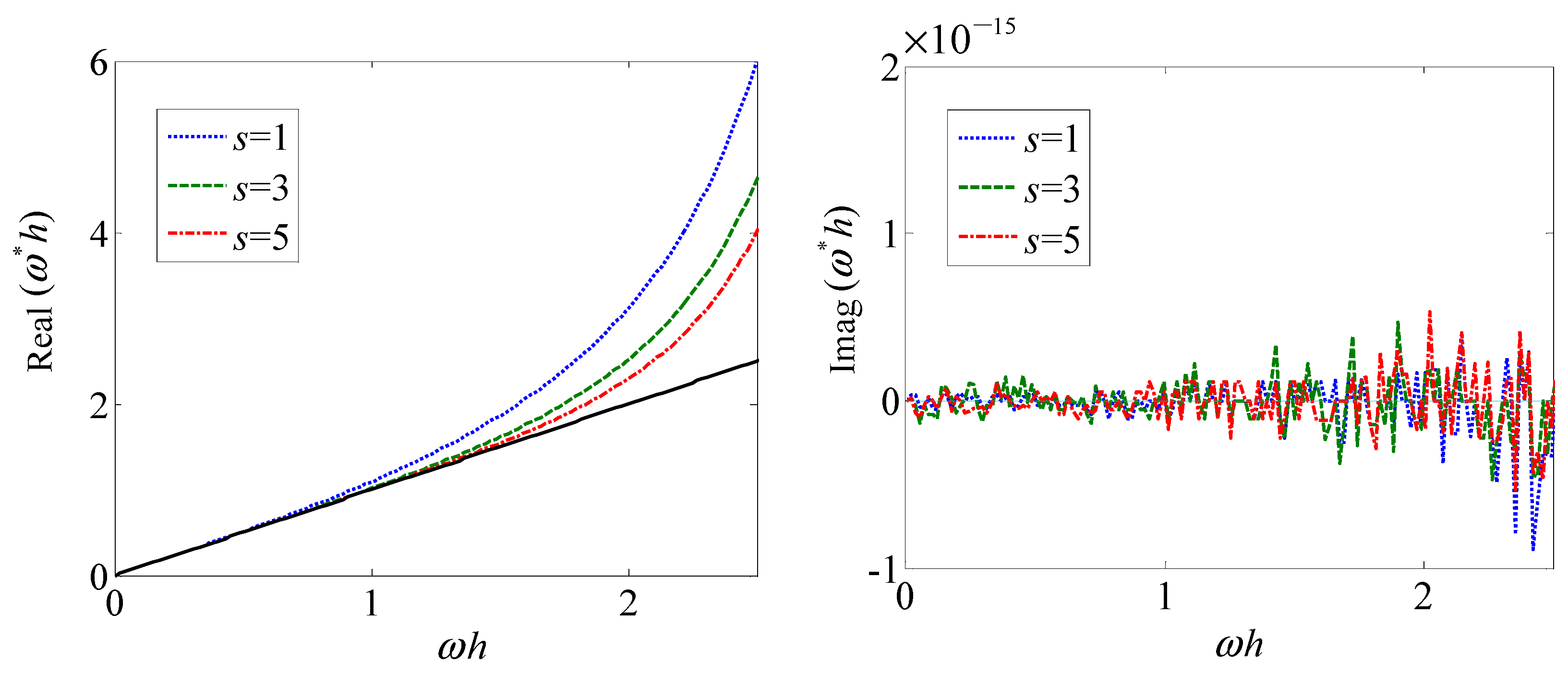1. Introduction
Many physical phenomena possess a range of space and time scales, and direct numerical simulations of these processes require all the relevant scales to be properly represented in the numerical model. These requirements have led to the development of the so-called compact finite difference scheme [
1]. Usually, the compact schemes have much smaller numerical dispersion and dissipation errors than traditional finite difference schemes of the same order of accuracy on the same mesh. So far, researchers have developed a variety of compact difference schemes [
2,
3,
4,
5,
6].
This paper presents a simple way for constructing the compact finite difference schemes by the use of the differential quadrature method (DQM). The DQM was firstly proposed by Bellman and Casti in the early 1970s [
7,
8]. The basic idea of DQM is to extend analogously the numerical integration rule to the numerical differentiation, where the derivative of a function on a coordinate direction is expressed as the weighted linear combination of function values for all discrete points along this direction.
At present, the differential quadrature method has been widely developed. According to the used trial or test function, the differential quadrature method generally includes the classical differential quadrature method, harmonic differential quadrature method, Fourier differential quadrature method, and so on. The classic differential quadrature method mainly uses the general polynomial or Lagrangian interpolation function as a test function, the harmonic differential quadrature method uses the trigonometric function as the trial function, while the Fourier differential quadrature method uses Fourier series expansion as the trial function [
9,
10]. Theoretically, the above differential quadrature rules can be used either for spatial discretization or for time discretization. In other words, the differential quadrature method can be used for the solution of both the partial differential equation and the ordinary differential initial problem [
11,
12,
13,
14,
15]. In summary, differential quadrature methods have the advantages of high precision, good numerical stability and convenient programming, and have been successfully applied in many fields [
16,
17].
Using classic differential quadrature formulae and uniform grids, we systematically constructed a variety of finite difference schemes, and some of these schemes are consistent with the boundary value methods (BVM) proposed by Brugnano et al. [
18,
19]. Considering that the derived difference schemes enjoy the same stability and accuracy properties with correspondent DQM but have a simpler form of calculation, the derived difference schemes can be regarded as the compact expression of classic DQM. Naturally, these compact difference methods could be used instead of classic differential quadrature methods for engineering applications [
20].
2. The Classic Differential Quadrature Methods
Suppose function
is sufficiently smooth in the considered interval, and the first-order derivative of
at each grid point
is approximated by a linear sum of all the function values in the whole domain, that is
The above Equation (1) is simply the basic expression of DQM, within which represents the weighting coefficient of DQM; s is the grid number of the partition of each interval; and represent the grid points.
The weighting coefficients of DQM only depend on the trial function and the discrete sample points, namely, the distribution of grid points, and have nothing to do with a specific problem. Usually, we would like to choose the general polynomial or Lagrange interpolation polynomial as the trial function, and use these functions to approximate the value of
at each grid points, which is defined as the classic DQM in this paper. The researchers have proved that the weighting coefficients derived by these two trial functions are consistent [
17]. The concrete calculation expression of weighting coefficients for classic DQM can be described as follows:
where,
Obviously, if the distribution of grid points is centro-symmetric in the normalized interval
, it can be deduced that
Defining
it can be known from Equation (5) that the weighting coefficient matrix
is centro-antisymmetric.
Regarding the selection of grid points, there are some commonly used approaches, including the uniform grids, Chebyshev grids, Chebyshev-Gauss-Lobatto grids, and Legendre grids. These types of grids can be concretely described as follows.
Take the following ordinary differentia initial value problem as an example
Supposing
and
represent respectively the starting point and ending point of an arbitrary interval,
is the interval length or the so-called stencil length. Let
and make the interval
normalized as
, then the Equation (10) can be converted into
On this basis, we can apply the
s-stage differential quadrature method (1) to Equation (11), and deduce that [
15,
16]
in which
,
,
If the initial value of is given, the value of state variable at different grid points, that is , can be obtained by solving the aforementioned nonlinear Equation (12).
It should be noted that, although the ordinary differential Equation (10) is used as a trial case, the variable
in this equation can either represent the space or the time, and naturally the stencil length
can be either a spatial discrete step size or a time discrete step. For ordinary differential initial value problems, it has been proven in reference [
15] that, when using uniform grids, Chebyshev grids and Chebyshev-Gauss-Lobatto grids, the classical DQM—i.e., Equation (12)—are all
s-stage
s-order methods with A-stability, while the classic DQM combined with Legendre grids can achieve the accuracy of 2
s-2 order.
3. Construction of Compact Difference Schemes by DQM
3.1. The Generalized Backward Differential Formulae
As shown in
Figure 1, we divide the interval
into
s segments, namely the grids, in which
,
,
.
Defining
and taking the
-th equation from Equation (12), we can obtain
in which,
It can be shown that the above numerical method (15) has the accuracy of s-order.
The numerical method (15) has a similar form to the traditional backward difference formulae (BDF), but we will later show that this method has the better numerical stability then traditional BDF. Thus, for the sake of simplicity, we define this numerical method as the generalized backward difference formulae (GBDF).
When selecting the uniform grids, the coefficient values (
) of GBDF are shown in the following
Table 1 and
Table 2.
For the uniform grids, we can define that
therefore, the Equation (15) can be rewritten as the following formula
It can be verified from
Table 1 and
Table 2 that, the numerical method (18) is consistent with the GBDF proposed by Brugnano et al. [
19]. In reference [
21], it has been shown that the methods (18) are both A-stable numerical methods for time-domain numerical integration.
3.2. The Central Compact Difference Schemes
As is shown in
Figure 1, let
s be an even number. By defining
and selecting the
-th equation in Equation (12), it follows that
in which,
It can be shown that the above numerical method (20) has the accuracy of s-order. Furthermore, it can be verified that the coefficients are centro-antisymmetrical about . If the distribution of grid points is centro-symmetrical in the normalized interval . So, the numerical method (20) can be called the central difference scheme.
When selecting the uniform grids, the coefficient values (
) of the method (20) are shown in the following
Table 3.
3.3. The Generalized Adams Methods
As is shown in
Figure 2, let
, and divide the interval
into
segments, in which
,
,
,
.
Define
then we can obtain the following formula according to Equation (12)
in which
,
;
.
Since it has been proved that [
12,
15]
where,
is the unit column vector, therefore, the Equation (23) can be rewritten as
Subtracting the
-th equation from the
-th equation in the matrix Equation (26) yields the following equation
where,
It can be shown that the above numerical method (27) has the accuracy of -order.
The numerical method (27) has a similar form to the traditional Adams methods, but we will later show that this method has the better numerical stability then traditional Adams methods. We call this numerical method the generalized Adams methods (GAMs).
When selecting the uniform grids, the coefficient values (
) of GAMs are shown in the following
Table 4 and
Table 5 respectively.
For the uniform grids, we can define that
therefore, the method (27) could be rewritten as
According to
Table 4 and
Table 5, we can verify that the proposed method (30) is consistent with the GAMs proposed by Brugnano et al. [
19]. In reference [
21], it has been shown that, for even
s, the methods (30) are both A-stable, and for odd
s the methods (30) are also A-stable while the stability region is just the complete left half plane.
3.4. The Extended Trapezoidal Rules
3.4.1. Extended Trapezoidal Rules of the First Kind
As is shown in
Figure 1, and let
s be an odd number. Define
then we can obtain the following formula via DQM
The same as Equation (12), Equation (32) is also the basic calculation scheme of DQM, however, the scheme of Equation (12) is more widely used in engineering application. In general, the matrix in Equation (32) is not a full rank matrix, so its inverse matrix does not exist.
If the distribution of grid points is centro-symmetrical in the normalized interval , the matrix in Equation (32) will be a centro-antisymmetrical matrix. Since the inverse matrix of does not exist, it is natural to consider its generalized inverse matrix. As is well known, the generalized inverse matrix—namely, the pseudo-inverse matrix of centro-antisymmetrical matrix with even order—will also be a centro-antisymmetrical matrix.
Define
then the Equation (32) can be written as
Subtracting the
-th equation from the
-th equation in the matrix Equation (34), we can obtain the following equation
It is obvious that the aforementioned Equation (35) is the GAMs with
-order, in which
Considering that
and
defined in Equation (33) is a centro-antisymmetrical matrix with even dimension, it can be easily proved that
in Equation (36) is centro-symmetrical. Therefore, Equation (35) can be further written as
When selecting the uniform grids, the values
are listed in the following
Table 6.
Obviously, when , the aforementioned Equation (37) is just the classic implicit trapezoidal rule, so, we call this numerical method the extended trapezoidal rules of the first kind (ETR1).
Although ETR
1 are simply the GAMs, the deduction method of these two methods is slightly different. Therefore, comparing
Table 6 with
Table 4, it can be clearly seen that the concrete results—i.e., the coefficients—are different.
It has been shown in reference [
21] that the stability regions of ETR
1 methods are the same as that of the classic implicit trapezoidal integration rule, and they are all A-stable methods.
3.4.2. Extended Trapezoidal Rules of the Second Kind
Let
s be an odd number, and the expression of
is also the same with Equation (31). According to matrix Equation (12), it can be drawn that
In the above matrix equation, add
-th equation to the
-th equation, we can get
where,
Considering that
, as well as the weighting coefficient
gpq is centro-antisymmetrical and
is centro-antisymmetrical, the Equation (39) could lastly be written as
where,
When selecting the uniform grids, the coefficient values (
) in Equation (41) are shown in the following
Table 7.
Obviously, when , the aforementioned method is just the implicit trapezoidal method; thus, this numerical method can be named the extended trapezoidal rules of the second kind (ETR2).
According to
Table 7, it can be verified that the method (41) is consistent with ETR
2 methods that proposed by Brugnano et al. [
19]. The stability regions of ETR
2 methods are the same with that of classic implicit trapezoidal integration rule, and they are all A-stable methods.
4. Fourier Stability Analysis for the Derived Compact Difference Schemes
Stability analysis is an important part of the numerical integration approach. In general, we use linear stability analysis by the use of a standard scalar test equation (
) [
21,
22,
23]. However, the linear stability analysis does not provide information about the performance of schemes at different length scales. Unlike this, the Fourier stability analysis provides an effective way to quantify the resolution characteristics such as dispersion or phase error of the differencing approximations. In this section, we analyze the dispersion and dissipation characteristics of the derived difference schemes using Fourier stability analysis [
1,
24].
By the Fourier stability analysis, different numerical schemes have different estimates of the modified scaled wavenumber, and it is in general a complex quantity [
25]. It can easily be shown that the real part of the modified scaled wavenumber tends to amplify/attenuate the corresponding Fourier mode while the imaginary part introduces a phase error. Thus the deviations of the real and imaginary parts of the modified scaled wavenumber from the exact scaled wavenumber can be respectively taken to be the indicators of numerical dissipation and dispersion. Furthermore, for numerical stability of any scheme, one must look at the imaginary part of the modified scaled wavenumber. The imaginary part of the modified scaled wavenumber represents numerical dissipation only when it is negative. Any scheme that produces a positive imaginary part of the modified scaled wavenumber is numerically unstable because a positive imaginary part is equivalent to adding anti-diffusion [
25].
Figure 3 shows the modified scaled wavenumber of GBDF based on uniform grids.
Based on the above results, we can see that GBDF are all stable numerical methods, and this kind of method has a strong numerical dissipation and dispersion.
Figure 4 shows the modified scaled wavenumber of central compact difference schemes (CCDS) based on uniform grids.
Based on the above results, we can see that CCDS have a strong numerical dispersion but have almost no numerical dissipation.
Figure 5a,b show the modified scaled wavenumber of GAMs based on uniform grids and respectively for even
s and odd
s.
Figure 6 shows the modified scaled wavenumber of ETR
1 based on uniform grids.
Based on the above results, we can see that the ETR1 are roughly equivalent to the GAMs with odd s in terms of numerical dissipation and dispersion. In fact, as mentioned earlier, these two methods are essentially the same.
Figure 7 shows the modified scaled wavenumber of ETR
2 based on uniform grids.
Based on the above results, we can see that the ETR2 are roughly equivalent to the ETR1 and GAMs with odd s in terms of numerical dissipation and dispersion.
To sum up, from the perspective of numerical dissipation, the CCDS, GAMs with odd s, ETR1 and ETR2 methods perform better than the GAMs with even s and GBDF methods, but from the perspective of phase dispersion, the high-order GBDF methods behave slightly better than other methods. In the wavenumber range , the proposed methods both have a high numerical resolution.
From the practical application of the point of view, the above different schemes have different practical application scenarios. For example, the GBDF method may be a better choice for electromagnetic transient simulation of electric power systems, because the dissipation of this method could avoid or effectively dampen fictitious numerical oscillations caused by abrupt phenomena. However, for electromechanical transient simulation of electric power systems, the GBDF method is likely to yield the wrong result due to the strong numerical dissipation: a stable system of its own, the corresponding simulation results may be stable. Based on the above analysis results combined with our experience, the high-order scheme of GAMs with even s and CCDS could be a better choice for electromechanical transient simulation of electric power systems.
5. Conclusions
Using the classic differential quadrature formulae while adopting the uniform grid points, this paper has symmetrically constructed a variety of compact difference schemes. Although some of the constructed methods in this paper are consistent with the boundary value method proposed by Brugnano et al., they are completely different in the means of construction. In fact, based on the methods described in this paper, it is easy to construct the compact difference schemes based on second-order derivatives.
Using Fourier stability analysis method, the characteristics such as the dissipation, dispersion and resolution of the different schemes were studied and compared. Based on these results, it is found that the CCDS, GAMs with odd s, ETR1 and ETR2 have almost no numerical dissipation, and GAMs, ETR1 and ETR2 have a high resolution when the wave number is not very large. In summary, the derived compact difference schemes in this paper could be used instead of classic differential quadrature methods for engineering applications.












